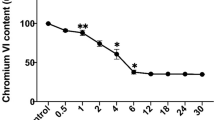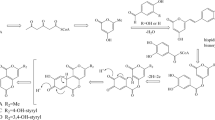Abstract
This study focused on the differences in protein expression at various periods during limonene biotransformation by Penicillium digitatum DSM 62840. A total of 3644 protein-species were quantified by iTRAQ during limonene biotransformation (0 and 12 h). A total of 643 proteins were differentially expressed, 316 proteins were significantly up-regulated and 327 proteins were markedly down-regulated. GO, COG, and pathway enrichment analysis showed that the differentially expressed proteins possessed catalytic and binding functions and were involved in a variety of cellular and metabolic process. Furthermore, the enzymes involved in limonene transformation might be related to cytochrome P-450. This study provided a powerful platform for further exploration of biotransformation, and the identified proteins provided insight into the mechanism of limonene transformation.




Similar content being viewed by others
References
Schrader J, Etschmann MMW, Sell D, Hilmer JM, Rabenhorst J (2004) Applied biocatalysis for the biosynthesis of natural flavor compounds-current industrial processes and future prospects. Biotechnol Lett 26:463–472
Rastogi SC, Heydorn S, Johansen JD, Basketter DA (2001) Fragrance chemicals in domestic and occupational products. Contact Dermat 45:221–225
Molina G, Bution ML, Bicas JL, Dolder MAH, Pastore GM (2015) Comparative study of the bioconversion process using R-(+)- and S-(–)-limonene as substrates for Fusarium oxysporum 152B. Food Chem 174:606–613
Bicas JL, Fontanille P, Pastore GM, Larroche C (2010) A bioprocess for the production of high concentrations of R-(+)-alpha-terpineol from R-(+)-limonene. Process Biochem 45:481–486
Rottava I, Cortina PF, Grando CE, Colla ARS, Martello E, Cansian RL et al (2010) Isolation and screening of microorganisms for R-(+)-limonene and (−)-β-pinene biotransformation. Appl Biochem Biotech 162:719–732
Bathia SP, Letizia CS, Api AM (2008) Fragrance material review on alpha-terpineol. Food Chem Toxicol 46:S280–S285
Fisher K, Phillips C (2008) Potential antimicrobial uses of essential oils in food: is citrus the answer? Trends Food Sci Tech 19:156–164
Jun M, Jeong WS, Ho CT (2006) Health promoting properties of natural flavours substances. Food Sci Biotechnol 15:329–338
Bicas JL, Neri-Numa IA, Ruiz ALTG, De Carvalho JE, Pastore GM (2011) Evaluation of the antioxidant and antiproliferative potential of bioflavors. Food Chem Tox 49:1610–1615
Rasoul-Amini S, Fotooh-Abadi E, Ghasemi Y (2011) Biotransformation of monoterpenes by immobilized microalgae. J Appl Phycol 23:975–981
Tai YN, Xu M, Ren JN, Dong M, Yang ZY, Pan SY et al (2016) Optimisation of α-terpineol production by limonene biotransformation using Penicillium digitatum DSM 62840. J Sci Food Agric 96:954–961
Li HJ, Lan WJ, Cai CH, Zhou YP, Lin YC (2006) Biotransformation of Limonene by Marine Bacteria. Chin J Anal Chem 34:946–950
Van der Werf MJ, Swarts HJ, de Bont JAM (1999) Rhodococcus erythropolis DCL14 contains a novel degradation pathway for limonene. Appl Environ Microbiol 65:2092–2102
van Dyk MS, van Rensburg E, Moleki N (1998) Hydroxylation of (+) limonene, (-) α-pinene and (-) β-pinene by a Hormonema sp. Biotechnol Lett 20:431–436
Duetz WA, Fjallman AHM, Ren SY, Jourdat C, Witholt B (2001) Biotransformation of D-limonene to (+) trans-carveol by toluene-grown Rhodococcus opacus PWD4 cells. Appl Environ Microbiol 67:2829–2832
Duetz WA, Bouwmeester H, van Beilen JB, Witholt B (2003) Biotransformation of limonene by bacteria, fungi, yeasts, and plants. Appl Microbiol Biotechnol 61:269–277
Prieto GA, Perea JA, Ortiz CC (2011) Microbial biotransformation of (R)-(+)-limonene by Penicillium digitatum DSM 62840 for producing (R)-(+)-terpineol. Vitae 18:163–172
van der Werf MJ, Keijzer PM, van der Schaft PH (2000) Xanthobacter sp. C20 contains a novel bioconversion pathway for limonene. J Biotechnol 84:133–143
Lerin L, Toniazzo G, de Oliveira D, Rottava L, Dariva C, Cansian RL et al (2010) Microorganisms screening for limonene oxidation. Ciênc Tecnol Aliment 30:399–405
Schalk M, Croteau R (2000) A single amino acid substitution (F3631) converts the regiochemistry of the spearmint (-)-limonene hydroxylase from a C6- to C3-hydroxylase. Proc Natl Acad Sci USA 97:11948–11953
Rottava I, Toniazzo G, Cortina PF, Martello E, Grando CE, Lerin LA et al (2010) Screening of microorganisms for bioconversion of (-)beta-pinene and R-(+)-limonene to alpha-terpineol. Lwt-Food Sci Technol 43:1128–1131
Bicas JL, de Quadros CP, Neri-Numa IA, Pastore GM (2010) Integrated process for co-production of alkaline lipase and R-(+)-a-terpineol by Fusarium oxysporum. Food Chem 120:452–456
Onken J, Berger RG (1999) Effects of R-(+)-limonene on submerged cultures of the terpene transforming basidiomycete Pleurotus sapidus. J Biotechnol 69:163–168
Zhang Y, Kang Y, Zhou QJ, Zhou JZ, Wang HJ, Jin H et al (2014) Quantitative proteomic analysis of serum from pregnant women carrying a fetus with conotruncal heart defect using isobaric tags for relative and absolute quantitation (iTRAQ) labeling. PLoS One 9:e111645
Ross PL, Huang YN, Marchese JN, Williamson B, Parker K, Hattan S et al (2004) Multiplexed protein quantitation in Saccharomyces cerevisiae using amine-reactive isobaric tagging reagents. Mol Cell Proteom 3:1154–1169
Huang Z, Wang H, Huang H, Xia L, Chen C, Qiu XX et al (2012) iTRAQ-based proteomic profiling of human serum reveals down-regulation of platelet basic protein and apolipoprotein B100 in patients with hematotoxicity induced by chronic occupational benzene exposure. Toxicology 291:56–64
Taylor KA, Feig M, Brooks CL 3rd, Fagnant PM, Lowey S, Trybus KM (2014) Role of the essential light chain in the activation of smooth muscle myosin by regulatory light chain phosphorylation. J Struct Biol 185:375–382
Kolla V, Jeno P, Moes S, Tercanli S, Lapaire O, Choolani M, Hahn S (2010) Quantitative proteomics analysis of maternal plasma in down syndrome pregnancies using isobaric tagging reagent (iTRAQ). J Biomed Biotechnol 2010:952047. doi:10.1155/2010/952047
Charbonneau ME, Girard V, Nikolakakis A, Campos M, Berthiaume F, Dumas F et al (2007) O-linked glycosylation ensures the normal conformation of the autotransporter adhesin involved in diffuse adherence. J Bacteriol 189:8880–8889
Marsh E, Alvarez S, Hicks LM, Barbazuk WB, Qiu WP, Kovacs L et al (2010) Changes in protein abundance during powdery mildew infection of leaf tissues of Cabernet Sauvignon grapevine (Vitis vinifera L.). Proteomics 10:2057–2064
Su LX, Zhou LS, Liu JW, Cen Z, Wu CY, Wang T et al (2014) Phenotypic, genomic, transcriptomic and proteomic changes in Bacillus cereus after a short-term space flight. Adv Space Res 53:18–29
Wang J, Yu LB, Huang XH, Wang YC, Zhao JZ (2016) Comparative proteome analysis of saccular intracranial aneurysms with iTRAQ quantitative proteomics. J Proteomics 130:120–128
Tian XX, Chen L, Wang JG, Qiao JJ, Zhang WW (2013) Quantitative proteomics reveals dynamic responses of Synechocystis sp. PCC 6803 to next-generation biofuel butanol. J Proteomics 78:326–345
Zhang W, Gritsenko MA, Moore RJ, Culley DE, Nie L, Petritis K et al (2006) A proteomic view of Desulfovibrio vulgaris metabolism as determined by liquid chromatography coupled with tandem mass spectrometry. Proteomics 6:4286–4299
Karp NA, Huber W, Sadowski PG, Charles PD, Hester SV, Lilley KS (2010) Addressing accuracy and precision issues in iTRAQ quantitation. Mol Cell Proteom 9:1885–1897
Marzinke MA, Choi CH, Chen L, Shih IM, Chan DW, Zhang H (2013) Proteomic analysis of temporally stimulated ovarian cancer cells for biomarker discovery. Mol Cell Proteom 12:356–368
Rodriguez-saiz M, Barredo JL, Moreno MA, Fernandez-canon JM, Penalva MA, Diez B (2001) Reduced function of a phenylacetate-oxidizing cytochrome p450 caused strong genetic improvement in early phylogeny of penicillin-producing strains. J Bacteriol 183:5465–5471
Eirich LD, Craft DL, Steinberg L, Asif A, Eschenfeldt WH, Stols L et al (2004) Cloning and characterization of three fatty alcohol oxidase genes from Candida tropicalis strain ATCC 20336. Appl Environ Microb 70:4872–4879
Cao YJ, Cheng T, Zhao G, Niu W, Guo JT, Xian M et al (2016) Metabolic engineering of Escherichia coli for the production of hydroxy fatty acids from glucose. BMC Biotechnol 16:1–9
Chowdhary PK, Alemseghed M, Haines DC (2007) Cloning, expression and characterization of a fast self-sufficient P450: CYP102A5 from Bacillus cereus. Arch Biochem Biophys 468:32–43
Furuya T, Shibata D, Kino K (2009) Phylogenetic analysis of Bacillus P450 monooxygenases and evaluation of their activity towards steroids. Steroids 74:906–912
Ito Y, Muraguchi H, Seshime Y, Oita S, Yanagi SO (2004) Flutolanil and carboxin resistance in Coprinus cinereus conferred by a mutation in the cytochrome b560 subunit of succinate dehydrogenase complex (Complex II). Mol Genet Genom 272:328–335
Baradaran R, Berrisford JM, Minhas GS, Sazanov LA (2013) Crystal structure of the entire respiratory complex I. Nature 494:443–448
Watt IN, Montgomery MG, Runswick MJ, Leslie AG, Walker JE (2010) Bioenergetic cost of making an adenosine triphosphate molecule in animal mitochondria. Proc Natl Acad Sci 107:16823–16827
Huang SB, Millar AH (2013) Succinate dehydrogenase: the complex roles of a simple enzyme. Curr Opin Plant Biol 16:344–349
Huang SB, Taylor NL, Narsai R, Eubel H, Whelan J, Millar AH (2010) Functional and composition differences between mitochondrial complex II in Arabidopsis and rice are correlated with the complex genetic history of the enzyme. Plant Mol Biol 72:331–342
Gan L, von Moltke LL, Trepanier LA, Harmatz JS, Greenblatt DJ, Court HM (2009) Role of NADPH-cytochrome P450 reductase and cytochrome-b5/NADH-b5 reductase in variability of CYP3A activity in human liver microsomes. Drug Metab Dispos 37:90–96
Syed K, Kattamuri C, Thompson TB, Yadav JS (2011) Cytochrome-b5 reductase- cytochrome b5 as an active P450 redox enzyme system in phanerochaete chrysosporium: atypical properties and in vivo evidence of electron transfer capability to CYP63A2. Arch Biochem Biophys 509:26–32
Karthikeyan S, Zhou QX, Mseeh F, Grishin NV, Osterman AL, Zhang H (2003) Crystal structure of human riboflavin kinase reveals a barrel fold and a novel active site arch. Structure 11:265–273
Kelly SL, Lamb DC, Cannieux M, Greetham D, Jackson CJ, Marczylo T et al (2001) An old activity in the cytochrome P450 superfamily (CYP51) and a new story of drugs and resistance. Biochem Soc Trans 29:122–128
Lepesheva GI, Waterman MR (2004) CYP51-the omnipotent P450. Mol Cell Endocrinol 215:165–170
Denisov IG, Makris TM, Sligar SG, Ilme S (2005) Structure and Chemistry of Cytochrome P450. Chem Rev 105:2253–2277
Meunier B, de Visser SP, Shaik S (2004) Mechanism of oxidation reactions catalyzed by cytochrome P450 enzymes. Chem Rev 104:3947–3980
Weitzel C, Simonsen HT (2015) Cytochrome P450-enzymes involved in the biosynthesis of mono- and sesquiterpenes. Phytochem Rev 14:7–24
Lerin L, Toniazzo G, de Oliveira D, Rottava L, Dariva C, Cansian RL et al (2010) Microorganisms screening for limonene oxidation. Ciênc Tecnol Aliment 30:399–405
Schalk M, Croteau R (2000) A single amino acid substitution (F3631) converts the regiochemistry of the spearmint (-)-limonene hydroxylase from a C6- to C3-hydroxylase. Proc Natl Acad Sci USA 97:11948–11953
Acknowledgments
This work was supported by Major Scientific and Technological Innovation Project in Hubei Province (2015ABA035), National Natural Science Foundation of China (Program No. 31101239) and the Fundamental Research Funds for the Central Universities (Program No. 2013PY097).
Author information
Authors and Affiliations
Corresponding author
Rights and permissions
About this article
Cite this article
Zhang, LL., Zhang, Y., Ren, JN. et al. Proteins differentially expressed during limonene biotransformation by Penicillium digitatum DSM 62840 were examined using iTRAQ labeling coupled with 2D-LC–MS/MS. J Ind Microbiol Biotechnol 43, 1481–1495 (2016). https://doi.org/10.1007/s10295-016-1826-7
Received:
Accepted:
Published:
Issue Date:
DOI: https://doi.org/10.1007/s10295-016-1826-7




